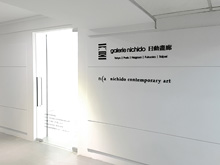Exhibitions
Yi-Chun Lo : Taste of Ocean

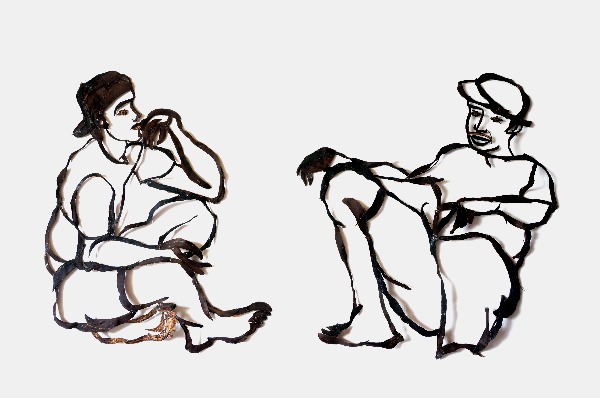
Download press release:
羅懿君 Yi-Chun Lo_海之味 Taste of Ocean_press release.pdf
Dates|2018. 07. 07 - 2018. 09. 01
Opening Reception|2018. 07. 07 15:00
Venue|台北日動畫廊 galerie nichido Taipei
galerie nichido Taipei is pleased to present the first solo show “Taste of Ocean” of artist Yi-Chun Lo. The artist tells the many different life experiences under globalization through her art creations made by dried bananas.
Yi-Chun Lo mainly focus on on-site, sculptural installations. Since 2012, she has been invited for residency projects in the U.S, Japan, Netherlands, India...etc. The multicultural experiences stimulated the artist’s interest in the environmental, social-political, and economic situation. During her residency in Japan in 2013, Lo started to develop series of works using dried bananas as her material to explore the history of trade and the impact of globalization for local economies. This project was rewarded Kaohsiung Art Awards in 2015. In the same year, she used banana again to create “Journey to the Homeland” to discuss issues of international immigrants and politics. The series exhibited in Aomori Contemporary Art Centre(ACCA)(Navigation & Trajectory, Aomori, 2015), galerie nichido Taipei(A Journey Far from Home, Taipei, 2017), and National Taiwan Museum of Fine Arts(Negotiating the Future: 2017 Asian Art Biennial, Taichung, 2017).
This exhibition is an extension of her previous project “Journey to the Homeland” collaborated with galerie nichido Taipei. It will consist of 30 portraits of migrant workers with several sculptural installations that touch upon migrating and economic themes. We invite visitors to examine how Lo transforms her personal interactions with these migrant workers into visible configurations, and to experience and reflect on the many tastes and meaning of life through her powerful creations.
---
Banana Peels and Migrant Portraits – Yi-chun Lo’s “Taste of Ocean” Exhibition
Text/ Jane Ingram Allen (Artist and Critic)
The exhibition titled “Taste of Ocean” by Taiwanese artist Yi-chun Lo features over 30 portraits of migrant workers in Taipei along with several larger installations related to issues of migration and the global economy, all made with dried banana peels. Yi-Chun Lo, born in Taipei, Taiwan, in 1985, received her MFA degree in Sculpture in 2010 from National Taiwan University of the Arts in Taipei. Since then she has exhibited her work widely in Taiwan, and she has traveled to other countries as an artist in residence to produce site-specific works and expand her artistic practice.She has been an artist in residence in Japan, India, the Netherlands and the USA, where she has experienced life in a foreign culture and become more concerned about global environmental, social and economic issues.
Lo began using banana peels to make her sculpture installations in 2013 during a residency in Japan. After researching her country’s history with Japan, she realized that many Japanese know Taiwan as their main supplier for bananas. Taiwan was known as a major banana exporter during the early 20th century. She began to study the history of banana trading and based these first banana peel works on a historic photo from the 1950s of workers in Taiwan packing bananas to ship to Japan(image 1) . Her “Banana Justice”(image 2) series created during a residency in the USA in 2014 at Contemporary Arts International, Acton, MA*1 included three more large banana peel installations. Lo continued her research about the global market and international fruit companies, “thinking how ironic that the banana, being one of the most nutritious foods to humans, turns into one of the most controversial objects in the world economy and social justice”. These works were “made entirely from collected recycled banana peels – the most basic fruit that is consumed on an everyday basis – to present the humble position of farmers, workers and common people in the world against mainstream ideologies such as globalization, capitalism and dictatorship.”*2 At a 2015 residency and exhibition called “Navigation & Trajectory”(image 3) at Aomori Contemporary Art Centre (ACAC) in Japan, Lo continued to use banana peels as her art material and focused her artworks on a current issue much in the news about refugees and global immigration. Among the sculptures in this exhibition are several refugee rafts suspended in the gallery space that reflect on the harsh and inhumane conditions endured by refugees and issues of immigration and border crossings.
With “Taste of Ocean”, Lo’s newest series created in 2018, she shifts the focus to Taiwan’s migrant workers who under the flow of globalization have crossed the ocean to work in Taiwan. This new series of banana peel works has evolved from her previous installations that were concerned about issues of immigration, refugees and global trade as well as research about the conditions immigrants and refugees faced on their ocean voyages and the often tough and bitter conditions of global human migration. As Lo says about the new work, “After I settled down in my original hometown in Taiwan, I saw there are more and more migrant workers around us, especially caretakers from southeast Asia that are almost everywhere in many households. These migrant workers come to Taiwan alone and are often working in an unfriendly environment. Therefore, I think this issue is something important around me and that we must face in Taiwan. I feel that I should talk more about migrant workers through my artwork. So, the subject has shifted from refugees to migrant workers in Taiwan.”*3
The works in this exhibition center on the experiences of migrant workers in Taiwan who usually come from Southeast Asian countries such as Indonesia, the Philippines, Vietnam and Bangladesh. They come to Taiwan, a relatively prosperous neighbor, for work, in order to send money back home to provide a better life for their families. The migrant workers are usually leaving family behind and often work long hours in low-paying menial jobs as caregivers for the elderly, housemaids or factory workers. Most of the foreign workers who come to Taiwan are placed in contract jobs by agencies with little resources to adjust to a different culture or navigate life alone in a busy urban environment such as Taipei. Some may experience abuse from employers, working long hours with little time off, and they get little attention from the government or society. Since resettling in Taipei after her residencies in other countries, Yi-chun Lo has spent Sunday afternoons at a park in downtown Taipei interacting with the many migrant workers who congregate there on holidays to converse and share food. Lo engages the migrant workers by asking if she can draw their portrait and getting them to tell their stories while she draws their portrait. At the end of the conversation and with the drawing completed and notes about the migrant’s story made on the back of the drawing, Yi-chun offers the portrait sitter a banana and tells them about her artwork. Sometimes she gets the banana peel back to use in her artworks, and the original sketches along with the stories are preserved.
Lo takes the portrait drawing back to her studio and uses it to compose her banana peel portraits and installation artworks. Sometimes it is a single person depicted, and sometimes it is a grouping of people interacting. The faces of the migrant workers are rendered with the dried blackened banana skins that invoke the transient nature of life as well as the hard labor of banana plantation life and the exploitation of workers in the global economy. The portraits with banana skins bring attention to the individual lives of migrant workers in Taiwan and more broadly help to raise awareness about the lives of migrant workers historically and globally in today’s economy.
In this exhibition Yi-chun Lo also presents a replica of a United East India Company (V.O.C.) ship made of banana peels. The suspended boat references international trade between Taiwan, Southeast Asia and Europe and also long, hard ocean voyages to a foreign land. Taiwan is very much related to Southeast Asia in history, economy and geography. Merchants have been crossing the ocean to Southeast Asia for business since the Ming Dynasty. During the 17th century, V.O.C or "Vereenigde Oost-Indische Compagnie" (United East India Company) was the largest commercial enterprise in the world, with a fleet of more than a hundred ships, thousands of employees, dozens of offices in Asia, and six establishments in the Netherlands. The East India Company’s Asian headquarters was in Batavia (now Jakarta), and they also established Fort Zeelandia in Tainan, Taiwan, that linked Taiwan and Southeast Asia into an important economic chain in the history of global trade. This company had a virtual monopoly of all sea-borne trade between Asia and Europe. With this new series of banana skin artworks about migrant workers in Taiwan, Lo provides a wider perspective from history to economy, as wells as references to global trade in bananas today that is monopolized by huge international fruit companies.
Banana peels are an unusual medium for sculpture, and one can get caught up in the sensual materials and the aesthetic appeal of the works, while overlooking the subject matter addressed by this artist. Lo’s banana skin installations assault the viewer visually as one enters her large black linear drawings in space; then other senses are awakened with the sweet decaying smell of banana peels and their rough organic texture. Lo's practice is not random, but carefully composed and orchestrated with conscious use of negative space and the effects of light and shadow as well as interactions with the space around and inside her sculpture installations. The banana skin artworks are put together over months of intense labor. For these artworks, Lo dried the collected banana peels in the strong sunshine of Taiwan, spreading them flat on her rooftop terrace and covering them with a net to keep them in place until dry. This slow process of sun drying preserves the banana peels well and also imparts the sweet smell of dried banana to the finished artworks. After drying the banana peels, she joins them with a non-acidic glue, and then puts raw lacquer (Urushi in Japanese) on both sides of the banana peel artworks as a natural protective material. The lacquer also gives a slight glaze to the surface and makes the banana peels a little darker in color. Lo’s powerful artworks stretch the limits and expand our viewpoints. They go far beyond the appeal of a novelty material to explore the lives of migrants and refugees today, the history of international trade, the economic exploitation of workers and other current global issues.
※1:http://www.contemporaryartsinternational.org/event/artist-in-residence-from-taiwan-lo-yi-chun/
※2:http://artradarjournal.com/2014/12/05/taiwanese-artist-yi-chun-lo-talks-bananas-and-economics-interview/
*3 From an email interview with Yi-chun Lo on June 6, 2018.
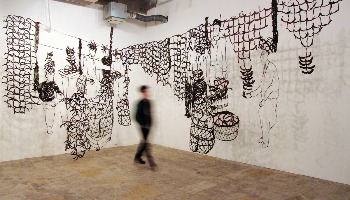
圖1 image 1
芭娜娜 • バナナ • Saging (Banana in Taiwan, Japan and the Philippines)
羅懿君 Yi-Chun Lo
2013, dried banana peels
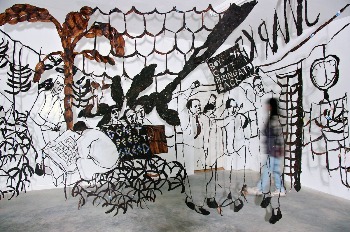
圖2 image 2
香蕉正義 Banana Justice - The Drama of Global Trades and Riots
羅懿君 Yi-Chun Lo
2014, dried banana peels
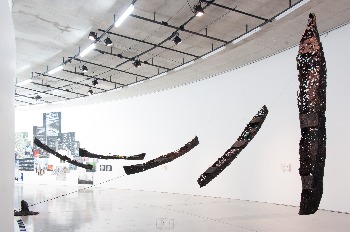
圖3 image 3
航向未知的家 Voyage to the Homeland
羅懿君 Yi-Chun Lo
2015, dried banana peels and mixed media
Gallery
